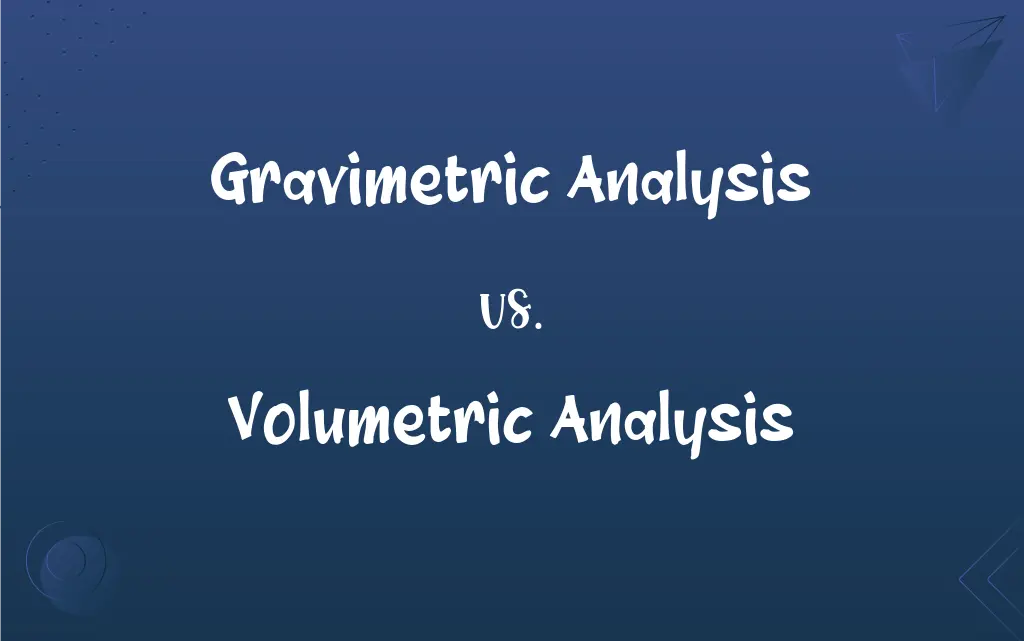Gravimetric Analysis vs. Volumetric Analysis: What's the Difference?
Edited by Aimie Carlson || By Janet White || Published on March 2, 2024
Gravimetric analysis involves measuring mass to determine substance quantity; volumetric analysis uses volume measurements for chemical quantification.

Key Differences
Gravimetric analysis relies on the precise measurement of a substance's mass for analytical purposes, while volumetric analysis depends on the measurement of volume to determine the concentration of substances in a solution. Each technique has its unique applications and limitations, but both are fundamental in analytical chemistry for quantifying substance amounts.
In gravimetric analysis, a sample's mass is measured after it has been transformed into a pure compound of known composition, whereas, in volumetric analysis, the volume of a titrant required to react completely with an analyte is measured. This difference highlights the contrast between the two methods: gravimetric focuses on mass changes, and volumetric focuses on volume changes.
The accuracy of gravimetric analysis often depends on the purity of the precipitate and the completeness of the separation, while the accuracy of volumetric analysis is influenced by the precision of volume measurements and the exactness of the chemical reaction. Thus, gravimetric analysis is typically used when high precision is needed, and volumetric analysis is preferred for its speed and convenience.
Gravimetric analysis techniques involve drying and weighing of the precipitate to determine its mass directly, offering a direct measure of the analyte. In contrast, volumetric analysis involves titration, where a known concentration of a reagent reacts with the analyte until a reaction endpoint is reached, indirectly measuring the analyte concentration.
Both gravimetric and volumetric analyses are critical in quality control, formulation of pharmaceuticals, and environmental monitoring. However, the choice between gravimetric and volumetric analysis depends on the specific requirements of the analysis, including accuracy, precision, and the nature of the sample being analyzed.
ADVERTISEMENT
Comparison Chart
Basis of Measurement
Mass of a pure substance
Volume of titrant used
Precision
High precision in mass measurements
Precision in volume measurements
Sample Preparation
Involves drying and weighing
Involves preparation of solutions
Time Efficiency
Generally more time-consuming due to drying and weighing steps
Faster as it involves direct titration
Suitability
Ideal for solid samples and high precision requirements
Preferred for liquid samples and quick analyses
ADVERTISEMENT
Common Uses
Determining purity, composition of solid substances
Determining concentration of solutions, acidity, or alkalinity
Gravimetric Analysis and Volumetric Analysis Definitions
Gravimetric Analysis
In gravimetric analysis, the mass of a precipitate formed from a solution indicates the amount of analyte present.
Gravimetric analysis was used to quantify sulfate ions by precipitating them as barium sulfate.
Volumetric Analysis
Volumetric analysis can also involve the use of a burette to deliver the titrant.
In determining the alkalinity of water, volumetric analysis employed a burette to add acid until the pH changed, indicating the endpoint.
Gravimetric Analysis
Gravimetric methods are based on the measurement of weight of a substance of known composition.
To assess the silica content in a water sample, gravimetric analysis was performed by weighing the isolated silica.
Volumetric Analysis
The technique is based on precise volume measurements of reactants.
Volumetric analysis of a salt solution required the accurate measurement of the titrant volume to reach the endpoint.
Gravimetric Analysis
Gravimetric analysis is a quantitative chemical analysis method that measures the mass of a substance to determine its concentration.
To determine the purity of gold, gravimetric analysis can be used by measuring the mass of the gold after separating it from impurities.
Volumetric Analysis
Volumetric analysis is a chemical analysis method that determines the concentration of a solution by titration with a solution of known concentration.
To find the concentration of an acid, volumetric analysis involves titrating it with a standard base solution.
Gravimetric Analysis
Gravimetric analysis involves converting the analyte into a pure compound that can be isolated and weighed.
The concentration of chloride ions in a sample was determined through gravimetric analysis by precipitating them as silver chloride.
Volumetric Analysis
In volumetric analysis, the endpoint of a titration is used to calculate the analyte concentration.
Volumetric analysis was utilized to determine the vitamin C content in juice by titrating it with a known solution of iodine.
Gravimetric Analysis
Gravimetric analysis requires the careful drying and weighing of the precipitate to ensure accuracy.
After precipitating the analyte, gravimetric analysis necessitates its drying and weighing for accurate quantification.
Volumetric Analysis
Volumetric analysis involves the use of indicators to signal the completion of the reaction.
A phenolphthalein indicator was used in volumetric analysis to determine the endpoint of an acid-base titration.
FAQs
What is gravimetric analysis?
It's a method to quantify a substance by measuring its mass after conversion to a known, pure substance.
What is volumetric analysis?
A technique to determine the concentration of an analyte through volume measurements of a solution of known concentration.
Is volumetric analysis suitable for all types of samples?
It's versatile but best suited for liquid samples where the reaction between analyte and titrant is known and straightforward.
How does gravimetric analysis differ from volumetric analysis in terms of precision?
Gravimetric analysis is often more precise due to direct mass measurement, whereas volumetric analysis's precision depends on accurate volume measurement.
Can gravimetric analysis be used for liquid samples?
It's primarily used for solid samples; liquid samples require conversion to a solid form.
What equipment is essential for gravimetric analysis?
Balances for precise weighing, ovens or desiccators for drying precipitates.
What equipment is essential for volumetric analysis?
Burettes for titration, flasks, and indicators to determine the endpoint.
How does the endpoint in volumetric analysis affect its accuracy?
The accuracy depends on the precise identification of the titration endpoint, often indicated by a color change.
Can volumetric analysis be automated?
Yes, automated titrators are available for high-throughput volumetric analyses.
What influences the accuracy of gravimetric analysis?
The purity of the precipitate and completeness of the separation process.
How does sample preparation differ between the two analyses?
Gravimetric analysis involves drying and weighing, while volumetric analysis requires solution preparation and titration.
What are the applications of gravimetric analysis?
It's used in the determination of metal content in ores, the purity of pharmaceuticals, and the composition of materials.
How does the choice of precipitate affect gravimetric analysis?
The precipitate must be pure, easily filtered, and of known composition for accurate results.
How do environmental conditions affect gravimetric analysis?
Humidity and temperature can affect the drying process and the stability of the precipitate.
What are the applications of volumetric analysis?
Commonly used in acidity or alkalinity measurements, concentration determination of solutions, and in various industries including pharmaceuticals and environmental monitoring.
What role do indicators play in volumetric analysis?
Indicators help identify the endpoint of the titration, crucial for accurate concentration calculations.
Can gravimetric analysis be used for gas analysis?
Indirectly, by absorbing the gas into a solution or converting it to a solid form that can be weighed.
How is the titrant chosen for volumetric analysis?
It must react completely and specifically with the analyte, with a known stoichiometry for precise calculations.
Can gravimetric analysis determine multiple components in a mixture?
It's possible but requires sequential or selective precipitation of each component.
Is volumetric analysis faster than gravimetric analysis?
Yes, because it involves direct titration without the need for drying and weighing steps.
About Author
Written by
Janet WhiteJanet White has been an esteemed writer and blogger for Difference Wiki. Holding a Master's degree in Science and Medical Journalism from the prestigious Boston University, she has consistently demonstrated her expertise and passion for her field. When she's not immersed in her work, Janet relishes her time exercising, delving into a good book, and cherishing moments with friends and family.
Edited by
Aimie CarlsonAimie Carlson, holding a master's degree in English literature, is a fervent English language enthusiast. She lends her writing talents to Difference Wiki, a prominent website that specializes in comparisons, offering readers insightful analyses that both captivate and inform.































































